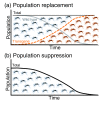Natural and engineered mosquito immunity
- PMID: 19439051
- PMCID: PMC2688914
- DOI: 10.1186/jbiol143
Natural and engineered mosquito immunity
Abstract
A recent paper in BMC Microbiology shows how suppression of mosquito innate immunity against a virus that the mosquito can normally tolerate increases mosquito mortality. This is just one of several approaches that may soon bring genetics-based mosquito control methods from the laboratory into the field.
Figures


References
-
- Collins FH, Sakai RK, Vernick KD, Paskewitz S, Seeley DC, Miller LH, Collins WE, Campbell CC, Gwadz RW. Genetic selection of a Plasmodium-refractory strain of the malaria vector Anopheles gambiae. Science. 1986;234:607–610. - PubMed
Publication types
MeSH terms
LinkOut - more resources
Full Text Sources
Other Literature Sources
Medical

